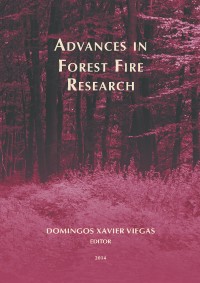Please use this identifier to cite or link to this item:
https://hdl.handle.net/10316.2/34015| Title: | A comparative study of parameter estimation and state estimation approaches in data-driven wildfire spread modeling | Authors: | Rochoux, M. C. Emery, C. Riccia, S. Cuenota, B. Trouvé, A. |
Keywords: | Data assimilation;Ensemble Kalman Filter;Wildfire;Fire modeling;Terrain topography | Issue Date: | 2014 | Publisher: | Imprensa da Universidade de Coimbra | Journal: | http://hdl.handle.net/10316.2/34013 | Abstract: | The objective of this work is to demonstrate the ability of the FIREFLY data-driven wildfire simulator to forecast the fire spread behavior over complex terrain topography. The prototype simulator features the following main components: a level-set-based fire propagation solver that adopts a regional-scale viewpoint, treats wildfires as propagating fronts, and uses a description of the local rate of spread (ROS) of the fire as a function of vegetation, topographical and meteorological properties based on Rothermel's model; a series of observations of the fire front location; and a data assimilation algorithm based on an ensemble Kalman filter (EnKF). The data assimilation algorithm also features a choice between a parameter estimation (PE) approach in which the estimation targets are the input parameters of the ROS model, and a state estimation (SE) approach in which the estimation targets are the spatial coordinates of the discretized fire front. This study shows the extension of the FIREFLY data-driven simulator to complex terrain topography. The fire propagation is represented by time-evolving two-dimensional fronts along the horizontal plane in order to remain consistent with the formulation of the PE-/SE-based EnKF algorithms that were initially developed for flat terrain configuration. While evaluated on synthetic cases in this study, the performance of the EnKF algorithm is shown to be preserved in the case of complex terrain. Thus, this study emphasizes the potential of data assimilation to dramatically increase wildfire simulation accuracy in real-world wildfire events. | URI: | https://hdl.handle.net/10316.2/34015 | ISBN: | 978-989-26-0884-6 (PDF) | DOI: | 10.14195/978-989-26-0884-6_1 | Rights: | open access |
| Appears in Collections: | Advances in forest fire research |
Files in This Item:
| File | Description | Size | Format | |
|---|---|---|---|---|
| 978-989-26-0884-6_1.pdf | 1.78 MB | Adobe PDF |  |
Items in DSpace are protected by copyright, with all rights reserved, unless otherwise indicated.
